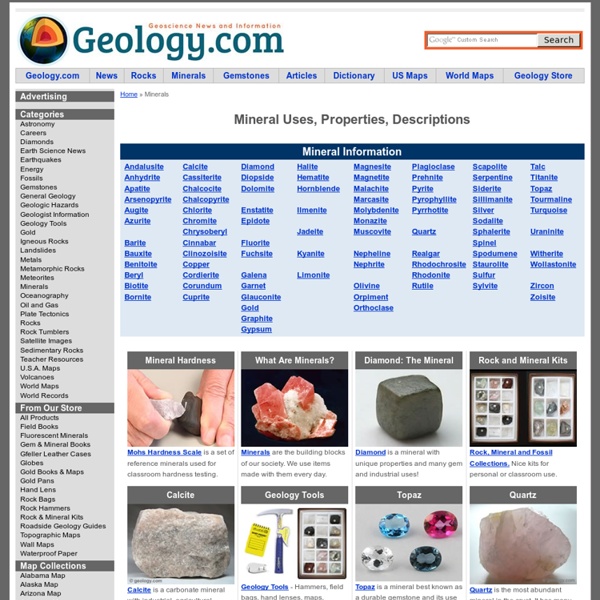



Videos - Geology Geology may be a science that moves very slowly, but a number of videos bring the subject to life for students. Education World compiled some great videos that will get kids excited about the topic. For each one, we include a description and grade level. We also note the video’s capacity for engagement (“cool factor”). The Geology and Formation of the Western Land of U.S. Source: World-earthquakes.com. Grade level: Sixth grade or higher Run time: 44:59 Description: This rather dramatic video shows geology in action—specifically, how the western part of the United States came to look the way it does. Cool factor: Not as cool as some, but dramatizations of geologic activities add interest. National Geographic Colliding Continents Source: National Geographic Grade level: All ages Run time: 50:05 Description: This video is a documentary of the Earth’s violent past and the movement of the tectonic plates. Geology Kitchen: What is a Mineral? Source: Explorer Multimedia Run time: 5:44 Source: IGP
Collecting Rocks by Rachel M. Barker Rocks Tell the Story of the Earth The Earth is made of rock, from the tallest mountains to the floor of the deepest ocean. Rocks are continually changing. Types of Rocks Geologists classify rocks in three groups, according to the major Earth processes that formed them. Igneous rocks are formed from melted rock that has cooled and solidified. Sedimentary rocks are formed at the surface of the Earth, either in water or on land. Sometimes sedimentary and igneous rocks are subjected to pressures so intense or heat so high that they are completely changed. Rock-forming and rock-destroying processes have been active for billions of years. Starting a Collection A good rock collection consists of selected, representative, properly labeled specimens. Identifying Rocks Many books about geology explain the identification and classification of rocks and describe the underlying geologic principles. Most geologic maps are issued by public or private scientific agencies.
Wegener's Puzzling Evidence Exercise (6th Grade) Although Alfred Wegener was not the first to suggest that continents have moved about the Earth, his presentation of carefully compiled evidence for continental drift inspired decades of scientific debate. Wegener's evidence, in concert with compelling evidence provided by post World War II technology, eventually led to universal acceptance of the theory of Plate Tectonics in the scientific community. The following files are needed for this exercise and can be downloaded in pdf format (Teacher Overview, (For Teachers) Wegener's Key to Continental Positions for grade 6, Student Puzzle Pieces, Key to Wegener's Evidence sheet, and Student Map of the World Today). If students need additional hints beyond those provided below, there is a Puzzle Outline Hint to be used as a base for the puzzle. Objectives Students will observe and analyze scientific evidence used by Wegener. The Student Puzzle Pieces and Legend To start this activity the teacher will present background information on Wegener.
Common Misconceptions About Rocks and Minerals — Rocks and Minerals Although the research base for geologic misconceptions is not as extensive as that of other disciplines within earth and space science, it is clear that students and teachers alike hold a wide range of incorrect ideas about rocks, minerals, and the rock cycle. To promote accurate scientific instruction, it is important that teachers are cognizant of their own understanding and seek to continually improve their content knowledge. Formative assessment can provide a great deal of insight into student thinking before, during, and after instruction. Finally, teachers should be metacognitive practitioners and reflect on how their methods of instruction may lead to the formation or strengthening of existing misconceptions. Geologic Misconceptions Geologic misconceptions can take many forms – the language used to define and describe specimens, relevant properties for classification, the rock cycle, and geologic time. Communication Breakdown Size Really Doesn’t Matter Good Looks Are Superficial
Rock and Mineral Prospecting Primitive Technology and Native Arts Continued from Page 1 Rock and Mineral Prospecting Any long-term survival training should include techniques for mining and collecting ores and other useful minerals. A mineral is composed of either a single element (like gold) or compound of elements (like sodium chlorine - aka table salt). Rocks are created initially by magma (below the surface) or lava flowing above the surface of the earth. Igneous - born directly from volcanic output, like granite and basalt Metamorphic - existing rocks that were reshaped after extreme pressure and heat, like slate Sedimentary - rocks composed of layers of clays, silts, fossils and other sediments eroded and washed away from mountains, like limestone and shale Minerals large enough to be visible to the naked eye were produced (in most cases)from magma that solidified below the Earth's surface. Over time, weathering, landslides and other forms of erosion peel or break down igneous rocks. Sulfur Mineral Identification